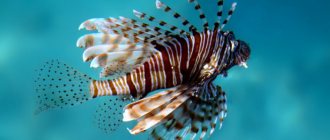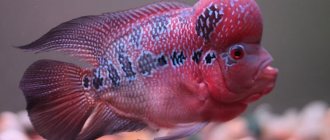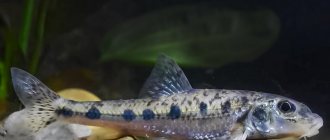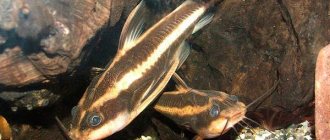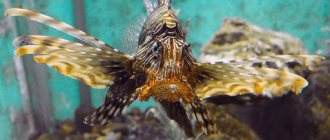Owners of suburban areas who are lucky enough to have a small artificial fish pond in their yard know how difficult it is to clean the tank. Therefore, it is recommended to carefully consider and balance the number of fish species so that with their help the pond is at least partially self-cleaning. Harmony in an artificial reservoir allows for less frequent cleaning and improves the appearance and health of its inhabitants. To make it easier to understand this issue, we present a list of fish that feel most comfortable in our climate, as well as their main characteristics:
White amur
They clean the pond well of various plants, feeding on them. He doesn't care what kind of grass he is fed. Even if you throw lawn grass into the pond, he will eat it with pleasure. They can grow up to 50 kg, and jump above the surface of the water to a height of 1 m. They can be grown in artificial reservoirs.
Read more information about grass carp fish in the article
Pike is a beneficial predator
Maximum length: up to 1.5 meters
Natural habitat: waters of Eurasia and North America
Pike - belongs to the pike family. The age of the common pike, according to leading ichthyologists, does not exceed 25 years. However, there is recorded information about the capture of a 33-year-old individual, but this is an exception. Pike is a very voracious fish. It eats not only small fish, but also frogs, water rats, and even squirrels swimming across a pond. Pike bite both on live bait and on artificial baits using a spinning rod. It is better to catch pike in the morning and evening. At noon and at night, the fish almost always sleeps.
Why is pike a water orderly?
Pike is a predator that tries not to chase its prey. She stands in ambush and waits until a weak and sick fish swims nearby and pounces on her. The pike rushes at its prey once and, if the attempt is unsuccessful, returns back to the ambush site. Chasing prey is not her strong point. By destroying weak fish, it prevents sick fish from spreading the infection throughout the reservoir and also promotes natural selection. It is for this reason that the pike was nicknamed “the orderly of reservoirs.”
When going fishing, you must always remember that if you engage in mass fishing of this predator, then a breeding ground for mass fish diseases may arise in the reservoir. The number of infected fish can reach 60%.
Decorative crucian carp
Perfect for a shallow reservoir, but only if there is no need to spend the winter. Individuals have an attractive appearance, their body is covered with golden scales that shimmer in the sunlight. The character is usually calm, the fish quickly get used to people and can even be taught to feed from your hand.
Lin - doctor of reservoirs
Maximum length: up to 70 cm
Natural habitat: basins of the Azov, Black, Caspian and Baltic seas, temperate zone of Eurasia, Europe.
Tench belongs to the carp family. The life expectancy of tench is up to 16 years. During life it grows very slowly. Body color can range from greenish-silver to dark brown with a bronze tint. Tenches live in algae and coastal vegetation, preferring to spend time in the shade of plants, and in case of danger they burrow into the mud.
It feeds on insect larvae, worms, mollusks, aquatic plants, and also includes detritus in its diet. Tench bite very reluctantly, and in winter they are not active at all. You can find tench in a pond by the characteristic bubbles in the water. They appear when fish dig through the mud in search of food.
Why tench is a reservoir orderly
Tench scales secrete a layer of antibacterial mucus, in which scientists have discovered a whole range of natural antibiotics. It helps fight diseases. Because of its peculiarity, the tench itself gets sick much less often than other cyprinids.
Other fish know about these unique properties. Wounded and sick individuals seek out tench to rub their wounds against its scales. The wound is disinfected and heals faster.
It is interesting that, for example, a tench will allow a sick pike to approach itself in order to cure it, and it will not attack it.
There are not many tench in our reservoirs, due to their small offspring, only about 400 thousand eggs, which are eaten by predators and animals before they hatch.
Fishermen love to catch tench for its dietary meat and there is no need to clean it from scales. However, it is always worth remembering the unique abilities of this fish, because apart from humans, tench has practically no enemies in the natural environment.
Diseases
Unfortunately, due to violation of conditions (exceeding the level of nitrates, nitrogen, low oxygen content), otocinclus can become seriously poisoned, including death .
In addition, parasites can appear in dirty water , which affect all inhabitants of the aquarium, not just catfish. Fish should be treated with special anti-parasitic drugs according to the instructions.
Otocinclus is a beautiful fish that is interesting to watch, and its contribution to the hygiene of the reservoir is truly great.
Fish fighting algae
These “cleanliness workers” are most often found in hobbyist aquariums.
Soma
The following are considered especially good “cleaners”:
- pterygoplicht (brocade catfish);
- Ancistrus vulgaris;
- otocinclus (dwarf catfish), which prefers diatoms.
With their suction cup, they thoroughly clean everything (bacterial film, algae fouling, other polluting organic matter), starting from the walls of the aquarium, soil, stones and ending with snags and large plant leaves. At the same time, they themselves are quite unpretentious, which is a definite plus.
The disadvantages include the large size and poor character of some of the catfish.
- For example, an adult pterygoplicht can grow up to 40-45 cm and begin to behave aggressively towards other inhabitants.
- If there is not enough food, some owners of “suckers” may begin to feed on the mucus of clumsy large fish, which are attacked under the cover of darkness.
- Sometimes catfish, overly keen on cleaning, damage the young tender tops of plants or make holes in young leaves.
- And some individuals, with age, begin to be lazy and perform their “responsibilities” poorly.
Dwarf catfish or otocinclus, an algae-eater from the chain-chain catfish family, copes best with brown diatoms. A school of five fish can easily keep a 100 liter aquarium clean. “Dwarf” is unpretentious, peaceful, and can get along even with large predators.
A “janitor” that can be seen less frequently, but this does not make it any worse: the royal panak, which belongs to the family of chain-mailed catfish. Large fish that will require a 200-liter (at least) aquarium. Young individuals are calm, but with age their character noticeably deteriorates. They get along well with peaceful characins. Panak is best at cleaning snags.
A suction cup with which chain catfish remove fouling from surfaces.
Gyrinocheilaceae
This family unites only three species of fish, the most popular of which are Gyrinocheilus.
Their lips are like a suction cup with folds on the inside. These bends form a kind of “grater”.
Thanks to this design, fish can stay on the rocks even in strong currents, while simultaneously scraping algae from their surface.
This food is not very nutritious, so Gyrinocheilus have to “scrape” a lot.
They cannot eat all filamentous algae, such as thread and blackbeard.
Negative points include
- damage to leaves, on which furrows and holes may remain after “harvesting”;
- a small number of fish is not enough to keep the aquarium clean;
- in large numbers they are aggressive and constantly attack their own kind, as they are territorial.
It is very difficult to achieve peace among them. You also need to select your neighbors carefully; you should absolutely not take slow fish.
Girinocheiluses mistake them for inanimate objects and can “clean” and severely damage the scales. They also have a bad attitude towards animals that have an elongated body and dark coloring - they perceive them as brothers and try to drive them away as far as possible.
Gyrinocheilus.
Viviparous
Many of them have a highly developed lower jaw, which resembles a scraper that easily removes plaque from walls, soil and plants.
The most popular cleaner livebearers are guppies, mollies, platies and swordtails. Some breeders claim that these fish can survive even without additional food, eating only green thread.
But they are only good as assistants to other algae eaters, since they are extremely reluctant to eat unwanted fouling.
Viviparous guppy fish.
Carp
The most tireless fighter against algae from this family is the Siamese algae eater (also known as Siamese crossochelius, or Siamese crossochelius, or Siamese epalceorhynchus).
Its strong point is green algae and the so-called “flip-flop” or “black beard” (these are growths in the form of dark tassels on stones, plant leaves and other places).
It also copes well with other algae in the form of fluff, since its mouth is best suited for this. To keep a 100-liter aquarium perfectly clean, it is enough to have only two (even the smallest) Siamese algae eaters.
The advantages of these fish are also activity, mobility, a fairly peaceful disposition, a small volume of vessel for normal existence and modest care.
Not without its shortcomings. After the length of the fish becomes more than 4 centimeters, they can begin to eat Java moss, if it grows in the aquarium, and much more readily than algae.
The way out of this situation is to plant larger mosses, such as fissidens.
It has also been noted that as they grow, Siamese algae eaters gradually become accustomed to fish food and over time may completely lose interest in fouling.
Another couple of “cleaners” from this family are bicolor labeo (bicolor) and green (phrenatus). Their mouthparts face downwards. Of course, they eat algae and fouling, but not as well as the previous ones. It's more like their hobby, so to speak. Their big disadvantage is their increased aggressiveness and territoriality towards both other fish and their own kind.
Siamese water sled in its typical stance. Study the fish carefully and remember its appearance, since pet stores often sell other species under this name.
Care, maintenance and breeding
Otocinclus is considered an unpretentious fish, it is suitable even for beginner aquarists.
Aquarium: requirements
Since the otik is a small fish, it does not require a large reservoir . Choose an aquarium from 50 liters with straight walls and a wide bottom.
At the bottom you must place driftwood or decorations that form a shelter for catfish .
Water parameters
The optimal water temperature for keeping otocinclus is 22…23 °C . Hardness should be in the range of 2–18 dGh, and acidity should be from 7 to 7.5 pH.
The water should be fresh, well aerated, low in nitrates and nitrogen compounds .
To ensure proper water quality, weekly changes of up to 30% of the volume are carried out; The aquarium is equipped with a high-quality aeration system and a powerful filter.
To prevent cases of small catfish being sucked into the filter tube, experienced aquarists recommend covering it with a grill.
Plants
Otocinclus is a very delicate fish; it manages to clear algae of the simplest flora without damaging them . Therefore, any type of algae can be planted in an aquarium with catfish.
Priming
The soil should be selected in the medium or fine fraction with rounded stones . Sharp corners and chips can lead to increased injury to fish.
Attention! Before placing the soil in a reservoir, it must be thoroughly rinsed in running water.
Lighting
Since aquariums inhabited by otocinclus always have enough plants and secluded corners, you need to choose a lamp for lighting based on the needs of the flora of the reservoir.
Feeding
The basis of the diet of otocinclus catfish is plant food . In principle, they are able to satisfy their needs through the simplest algae, but such a diet does not contribute to the quality of life of fish. To diversify the otik menu, use:
- spirulina;
- zucchini;
- lettuce leaves;
- spinach;
- green pea;
- special flakes for catfish.
You can add a small amount of protein by introducing gammarus, daphnia or brine shrimp into the diet .
How to distinguish a male from a female
Sexual dimorphism in Otocinclus is weakly expressed . The female can be distinguished only by the slightly more rounded outline of the abdomen and slightly larger proportions of the body.
Spawning
Typically, otikas reach sexual maturity by 7 months. Before producing offspring, producers need to diversify their menu as much as possible, enriching it as much as possible with protein foods.
Attention! Spawning often occurs without the knowledge of the aquarist, but ideally a couple of otocinclus should be placed in the spawning tank.
Incubator
The optimal size of the spawning tank is from 30 to 60 liters . The water should be clean, fresh, saturated with oxygen (equip the incubator with a good aerator).
Since catfish attach eggs to driftwood or algae leaves, the spawning tank must contain sufficient quantities of plants and decorative elements . The optimal water temperature is 23 °C.
Once the spawners have spawned, they should be returned to the main body of water. The temperature of the water in the incubator is gradually increased to 26 ° C, and a weak solution of methylene blue is added to prevent the development of fungus.
Raising fry
In such conditions, the fry emerge from the eggs by the end of the first week . When the fish hatch, stop adding the blue solution.
On the 3rd–4th day, ground egg yolk, ciliates or microworms are introduced into the fry’s diet. Don't forget about algae - this is the basis of the diet of otocinclus.
Shrimp fighting algae
These arthropods are rightly called champions of cleanliness. Freshwater shrimp are especially good, their bodies are equipped with special “fans”.
These outgrowths filter the water and extract from it uneaten food, plant particles and what remains of dead inhabitants. The males loosen the soil and filter out the dregs that have risen. Females remove dirt from the bottom surface.
In addition to filtering water, these creatures remove fuzzy algae from plant leaves and all other surfaces, and much more successfully than fish.
The reason is simple - shrimp, especially cherry shrimp, can get into the smallest nooks and corners of the aquarium.
Negative points:
- a small shrimp can only handle a small amount of work;
- To keep the aquarium really clean, you will need a lot of shrimp (one individual per liter);
- they are very defenseless and can be eaten by fish, as a result of which neighbors need to be selected especially carefully, plus create a lot of reliable shelters.
In addition to cherry shrimp, amano shrimp are good at fighting algae. They keep cladorf balls perfectly clean and eat filament.
Important! The efficiency of “work” is affected by their size. The larger the shrimp, the tougher strands of algae it can eat. Four-centimeter arthropods are considered the best.
5 of these pieces are enough for 200 liters. Three-centimeter fish will need 1 individual for every 10 liters of water. You need even more small ones (1-2 for every liter). The last option is the most unproductive and the most expensive. It is also worth noting that these shrimp do not eat xenococus and other green algae in the form of plaque. Black beard is also used reluctantly.
Another species is neocaridins. They are the most common among hobbyists, as they are very easy to breed. They are small, only 1-2 cm long, so you will need a lot of “combat units” (one individual per liter). Preference is given to soft filamentous algae such as Rhizoclinium. Neocaridins are the best choice for planted aquariums. They are also indispensable in a newly started aquarium, as they help establish balance. In adults they maintain balance.
Amano shrimp.





